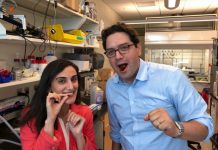A research team in Portland, Oregon just broke new ground and became the first scientists in the U.S. to edit genes of human embryos. The team used the Crispr gene-editing technique to splice out inherited disease from single-celled embryos, according to a report by MIT Technology Review.
We don’t actually know exactly what inherited diseases were eliminated from the embryos. Lead scientist on the study, Shoukhrat Mitalipov, declined to comment on the experiment pending future publication of the findings.
But we do know two things that make this experiment groundbreaking: First, researchers worked on dozens of embryos – a larger amount than any previous study. Second, the experiment successfully avoided a lot of the gene-editing errors we’ve seen in other experiments.
Ever-more precise
Researchers in China were the first to introduce gene-editing on human embryos with an April 2015 experiment with mixed success. They’ve made more experiments since with one experiment in March using viable embryos. Still, such experiments tend to suffer from an error called “mosaicism” where not all the cells of an embryo take up the changes and the child may ultimately inherit the disease despite the procedure. According to MIT’s report, Mitalipov not only reduced the instances of mosaicism in their experiment, they also largely avoided “off-target” edits where the wrong gene may get edited by accident.
Mitalipov’s goal in conducting this experiment is to demonstrate that the technology can be used precisely and effectively to eliminate genetic disease in embryos. It’s believed the team experimented on dozens of embryos donated from fathers with known inherited diseases and they were edited almost at the moment of fertilization so that the team only had to work with a single cell each. While they weren’t allowed to develop for more than a few days, they were deemed of clinical quality and could probably have survived to term.
Uncharted ethical territory
While the feat is notable for its precision, the experiment will only ratchet up the heated ethical debate over using Crispr on humans and the possible advent of “designer babies”. Last February, the National Academy of Sciences weighed in with the U.S.’s first real guidelines around Crispr research and germ-line editing. In a report, they gave what many took as a highly-caveated greenlight on genetic modifications of human embryos for the specific purpose of eliminating serious and inherited disease.
And one of Crispr’s primary inventors, Jennifer Doudna, has been outspoken in her appeal for more government guidelines to set some ethical boundaries right now before major experiments begin.
“Once that begins, I think it will be very hard to stop,” she said, according to Wired. “It’ll be very hard to say, ‘I’ll do this thing but not that thing.’ And at that point, who decides?”











